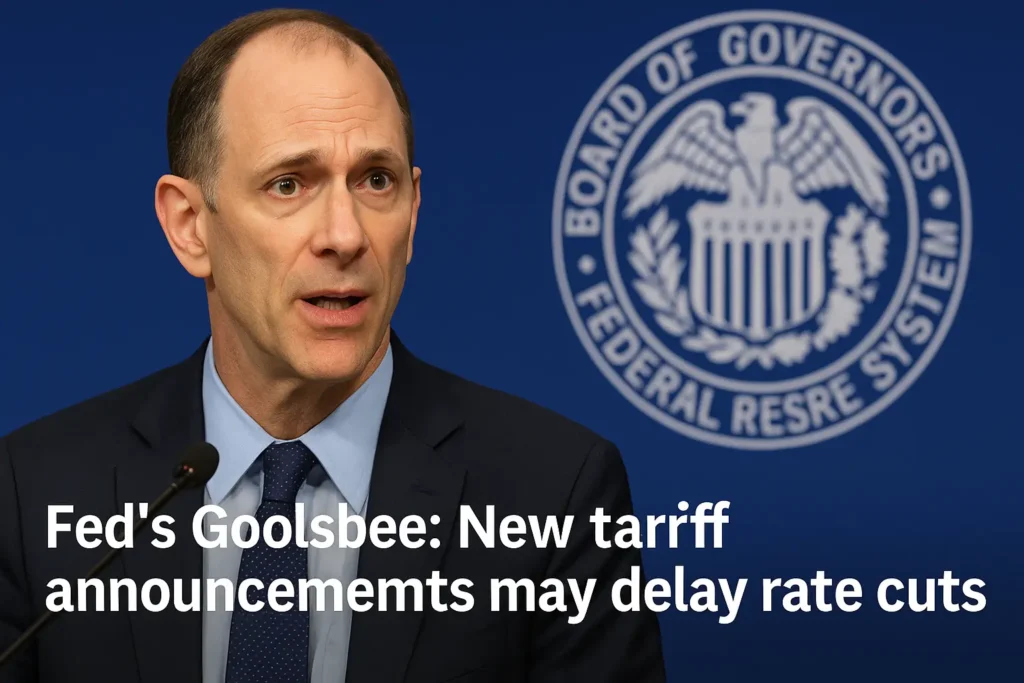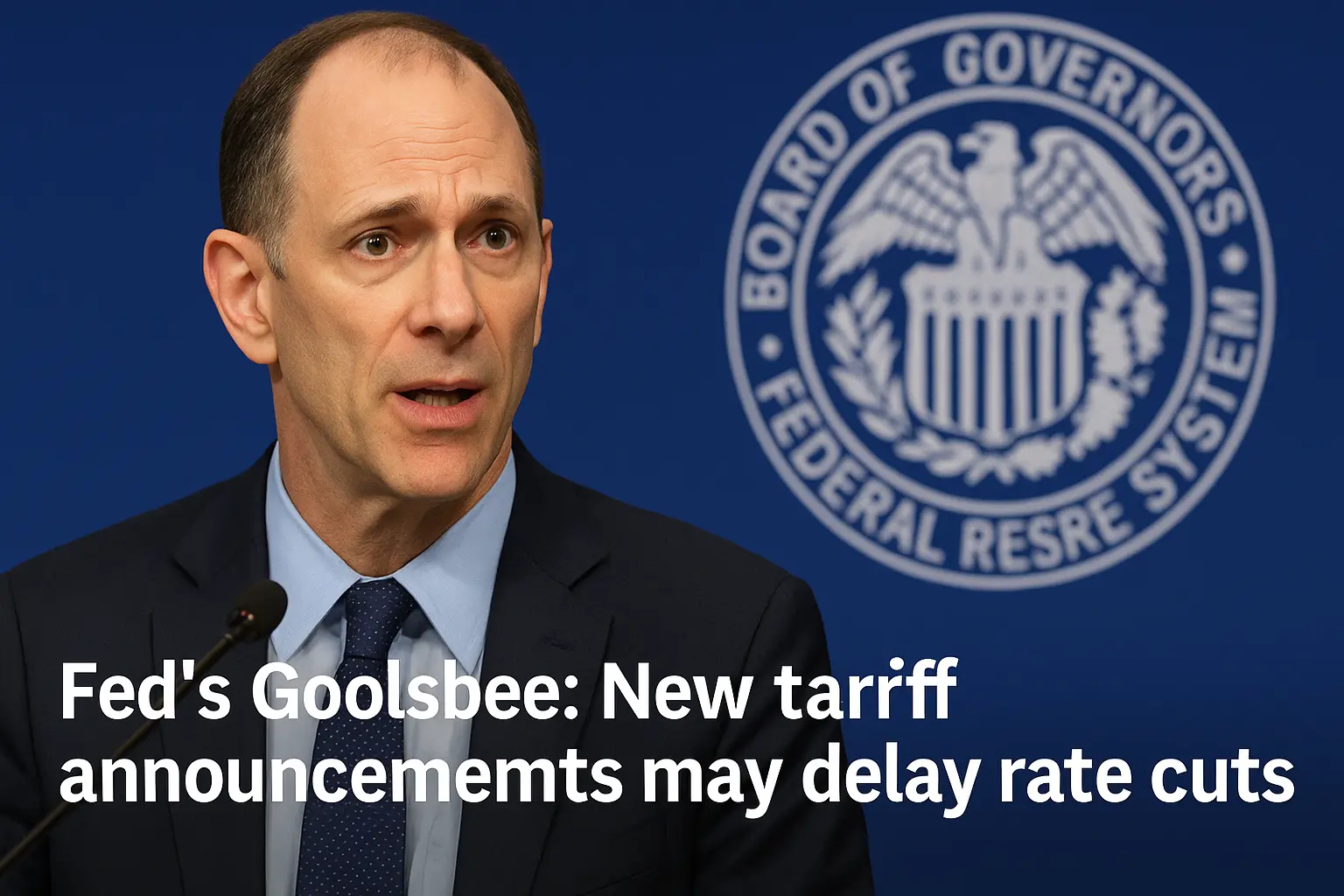Fed’s Austan Goolsbee warns that new tariff announcements may delay interest rate cuts. Learn how tariffs could fuel inflation, impact Fed policy, and affect your mortgage, credit, and investments.
Interest rates may stay higher for longer—and tariffs could be the reason. That’s the latest warning from Austan Goolsbee, president of the Federal Reserve Bank of Chicago, who says recent tariff announcements could throw a wrench into the Fed’s plan to cut interest rates.
While the Fed has been slowly preparing markets for possible rate cuts later in 2025, Goolsbee’s recent comments suggest that new trade tensions—especially in the form of tariffs—may force policymakers to hit the brakes on any easing.
For American consumers, businesses, and investors, this adds a new layer of uncertainty to an already delicate economic environment.
So, what exactly is going on? Why would tariffs affect interest rates? And what does this mean for your wallet?
Let’s break it all down in plain English.
📢 What Did Goolsbee Say?
In a recent public appearance, Austan Goolsbee made it clear: newly announced tariffs could make it harder for the Fed to cut interest rates.
“If tariffs go up and drive inflation higher, we may not be able to move as quickly as some might hope,” Goolsbee stated.
He emphasized that the Federal Reserve’s top priority remains getting inflation under control. And if import taxes on foreign goods push prices upward again, it could delay or derail the Fed’s expected policy shift toward lower rates.
In short, the Fed might have to keep interest rates elevated to fight renewed inflation—even if the broader economy is slowing.
📦 Why Do Tariffs Affect Interest Rates?
It might sound complicated, but here’s a simple way to look at it:
- Tariffs = Taxes on Imports
- These taxes usually raise the cost of imported goods
- That increases prices for consumers and businesses
- Which can drive up inflation
Now, the Federal Reserve uses interest rates to control inflation. When inflation is high, the Fed raises rates to cool down spending and borrowing. When inflation is low or the economy weakens, the Fed can lower rates to stimulate growth.
So if tariffs push inflation higher again, the Fed can’t safely cut rates—because doing so would fuel more inflation.
That’s why Goolsbee and others at the Fed are watching trade policy very closely right now.
🇺🇸 What Tariffs Are We Talking About?
The Biden administration recently announced a new wave of tariffs, aimed primarily at China and other foreign manufacturers in key industries like:
- Electric vehicles (EVs)
- Semiconductors
- Solar panels
- Steel and aluminum
These new tariffs are part of a broader effort to protect American industry and counter China’s growing dominance in high-tech manufacturing.
For example:
- Tariffs on Chinese EVs will quadruple from 25% to 100%
- Semiconductor tariffs will double from 25% to 50%
- Solar cell tariffs will jump from 25% to 50%
These are big increases, and they come at a time when supply chains are still recovering from the pandemic and geopolitical tensions are rising.
📈 How Tariffs Could Reignite Inflation
Here’s how these new tariffs could translate to higher prices:
- EV manufacturers may raise car prices to offset higher import costs
- Electronics could become more expensive due to costlier semiconductors
- Home energy upgrades like solar panels might cost more for homeowners
- Steel prices could rise, pushing up construction and manufacturing costs
Even if these tariffs are targeted, they can ripple through the economy.
Businesses facing higher costs tend to pass those costs onto consumers. That means higher inflation, which directly impacts the Fed’s decision-making on rates.

🏦 Why the Fed Is in a Tough Spot
The Federal Reserve is already walking a tightrope.
On one hand:
- Inflation has come down significantly from its peak in 2022
- The Fed wants to avoid over-tightening and choking off economic growth
- Many Americans are feeling the squeeze from high interest rates on mortgages, car loans, and credit cards
On the other hand:
- Inflation remains above the Fed’s 2% target
- The job market is still tight, suggesting the economy can handle higher rates
- Now, tariffs could push prices higher again
If the Fed cuts rates too soon and inflation rises again, it could lose credibility and have to hike rates all over again.
That’s the risk Goolsbee is warning about.
💸 What This Means for You
Let’s talk about the real-world impact on American households and investors.
1. Mortgage and Loan Rates Could Stay High
If rate cuts are delayed, mortgage rates may remain around 7% or higher. That affects:
- Homebuyers trying to afford monthly payments
- Homeowners hoping to refinance
- Construction and housing demand overall
Auto loans and credit cards will also remain expensive to carry.
2. Investors Should Brace for More Volatility
Markets have been pricing in rate cuts later this year. If the Fed delays, expect:
- Stock market pullbacks, especially in rate-sensitive sectors like real estate and tech
- Bond yields to stay elevated, which may keep pressure on equities
- A stronger U.S. dollar, which could impact multinational company earnings
3. Inflation May Creep Back Up
Tariffs could lead to price hikes in imported goods, especially tech and vehicles. Everyday products may also feel the impact, particularly if supply chains are disrupted again.
📊 What Are the Markets Saying?
Following Goolsbee’s comments, markets reacted with caution:
- The 10-year Treasury yield edged higher, reflecting inflation concerns
- Rate futures traders lowered their odds of a rate cut in September or November
- Tech stocks dipped, especially those reliant on Chinese imports
Investors are now rethinking the timeline for Fed easing, and many economists are revising their forecasts for only one or two cuts in 2025, down from three or four earlier this year.
🧠 Expert Opinions
Plenty of analysts are now weighing in.
“If tariffs push inflation up even 0.3% or 0.4%, that’s enough to keep the Fed on hold,” said a strategist at JPMorgan.
“This could be the beginning of a new era of trade-driven inflation, which complicates monetary policy,” added an economist at Goldman Sachs.
“The Fed won’t act until it sees clear, broad-based disinflation. Tariffs muddy that picture,” warned a former Fed advisor.
🔮 What to Watch Going Forward
Stay alert for these key developments:
- CPI and PCE inflation reports — Are prices rising again?
- Retail sales data — Is consumer demand holding up?
- Manufacturing costs — Are input prices rising?
- Fed statements and speeches — Watch for language on trade, tariffs, and inflation
Also, keep an eye on global trade tensions. If China retaliates with tariffs of their own, this could escalate into a broader trade war, which would be even more inflationary and economically damaging.
💬 Final Thoughts
Goolsbee’s warning is a reminder that monetary policy doesn’t operate in a vacuum.
The Fed is being forced to balance not just inflation and employment, but also global politics, supply chain dynamics, and now tariff wars.
For the average American, it means:
- Higher borrowing costs for longer
- More expensive imported goods
- Continued volatility in the markets
If you’re a borrower, buyer, or investor—don’t count on rate relief too soon.
The economic winds are shifting again, and once more, trade policy is at the center of the storm.

Must Read
Nvidia CEO: If I Were 20 Again, This Is the College Field I’d Focus On
